About Citrus Pages

Vangasay lemon
© Gene Lester

Indio
Mandarinquat
© Joe Real

Yuzu
lemon © Laaz |
I
started Citrus Pages in 2006. I was looking for information on the
Internet about the most common citrus types with representative
pictures of
each variety. I found a lot of information on many sites but I missed a
comprehensive approach arranged by groups and species combined with
decent photographs. I could not find one. I thought long about creating
my own site but the crucial thing was how to obtain good pictures. I
wanted my site to differ from so many other citrus sites by having, if
possible, a photo of each variety.
Before starting I wrote to some of
the biggest citrus research centres and universities around the world,
presented my plan and asked if they would agree to provide pictures for
my site. I promised I would credit the organisation or person holding
the copyright under each picture. To my surprise many agreed.
All
of them are listed on the Photos & links page.
My
first plan was to include the most common edible citrus fruits only,
around 200 varieties. The plan was completed early 2007 and I
was
happy with it. I soon received e-mail where people were
enthusiastic
about the site but asked questions like: "Why no kumquats?", "Where are
the Australian citrus?" I gave a deep sigh and was again
confronted
with the same problem. I have enough information but no
photos. Another round of e-mail went out and again I received many
replies. By early 2008 this site found its present form with around 400
citrus varieties and included further groups like Papedas and
Trifoliate orange with other rootstock.
Thanks to research
centres like INRA Corsica, University of California Riverside, Texas
A&M University and many citrus growers and enthusiasts like
Gene
Lester, Joe Real and Laaz in
the United States and Mike Saalfeld and Petr Broža in Europe I have
many new high definition photographs. There are also several citrus
varieties of which there previously was no
photo available on the Internet. |
Citrus fruits
| Combined
together the citrus family is the largest group of commercially grown
fruit. Bananas
come second, with grapes in third place. Citrus Pages
now also include Kumquats, Papedas, and Native
Australian
citrus as well as Trifoliate orange and other rootstock. More distant
citrus relatives also
have a page. There are 310 varieties
with a short description and a photograph. About 90 closely related
cultivars are mentioned
in
addition. Of
the 310 citrus types 131 have been assigned a botanical name
at
one
time or another. The botanical
index lists approximately 270
alternative Latin
names for them, each with its respective author. |
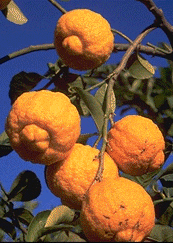 |
A little bit of history
2007/08
World citrus production |
|



 |
|
In the 2007/08
season the biggest citrus producers
were
1. China, 2. Brazil, 3. United
States, 4.
Mexico and 5. Spain.
However, the biggest citrus exporters
were
1. Spain, 2. South Africa, 3. United States
(oranges, grapefruit, grapefruit juice, lemons and limes),
4.
Turkey, 5. Argentina, 6. China, 7. Mexico
and 8.
Morocco.
The biggest citrus importers
by far are the 27 EU countries whose main EU external imports come from
South Africa, Argentina and Turkey. After EU the biggest importers
are 2. Russia, 3. United States (orange
juice,
lemons,
limes and mandarins), 4. Canada, 5.
Japan, 6.
Ukraine, 7. Hong Kong, 8.
Malaysia, 9. Switzerland
and 10. Indonesia.
(Source: USDA Foreign Agricultural Service:
Citrus World Markets and Trade, 4/2008.)
The biggest production areas of orange juice are Sao Paulo, Brazil and
Florida, US. The biggest orange juice consumers are U.S., EU,
Canada, Russia and Japan. A
new feature that has emerged in the last few decennia is the year-round
availability of citrus fruit in the biggest consumer areas of
North America and Europe. Because of the development of new late
maturing cultivars the first ripe fruit of the new season are available
in South Africa, Argentina, Australia and Brazil before the
previous crops
are finished in the northern hemisphere. After six months the situation
is reversed.
It is important
to remember
that unlike most other commercially grown fruit the majority of the
citrus
fruits (oranges, mandarins, lemons, citrons and most grapefruit)
mature during the local winter. In Europe the high season is from
November to March. Including the early and late varieties the whole
season lasts from October to May. Citrus fruit of the tropical climate
(limes, pomelos and some grapefruit types) are an exception to this.
Some pomelos can bear four crops in a year and some limes are picked
once a month throughout the year.
|
Botanical names of citrus
plants
 |
Why
are some botanical names on Citrus Pages different from names used on
other websites?
Starting
from 1994 the oldest
correct classification of a plant is the one to be used in scientific
studies
accompanied by the name of its author ( Tokyo Code 1994, Chapter II,
Section III, Article 11.3. where it says: "For
any taxon from family to genus inclusive, the correct name is the
earliest legitimate one."There is a more detailed discussion of
legitimate botanical names on
the Citrus
classification page where
the famous classifications of Volkamer,
Gallesio,
Risso
& Poiteau, Swingle, Tanaka
and
Mabberley are discussed.
|
Edible citrus |


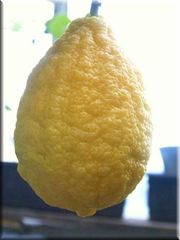

|
Of
modern botanists D.J.
Mabberley (b.1948), since 2005 president of IATP, has
presented the most interesting new
views on citrus
and the relationships between citrus types. In
A
classification for edible Citrus from 1997 and CITRUS Linnaeus from 2008 Mabberley states that
in the edible citrus group there are only three citrus species, citron, pomelo and mandarin, which
are then involved
in several
hybrids as follows:. 1. Citrus medica, citron, which is involved in - Citrus × limon, (citron × sour orange) lemon and similar hybrids like Palestine Sweet lime and Volkamer lemon.
- Citrus × jambhiri, (citron × mandarin) rough lemon and similar hybrids like Rangpur lime, Mandarin lime and types like 'Otaheite'.
- Citrus × aurantiifolia, (citron × lemon × Ichang papeda) lime (Mexican lime)
- Citrus × bergamia, (citron × sour orange) bergamot, also considered a citron × sour orange cross.
2. Citrus maxima, pomelo, which is involved in a) Citrus × aurantium (pomelo × mandarin) which includes three pomelo hybrids
- Citrus × aurantium (pomelo × mandarin) sour orange. The sour orange has inherited more features of pomelo than mandarin.
- Citrus × sinensis (pomelo × mandarin) sweet orange. The sweet orange has inherited more features of
mandarin than pomelo. This group also includes all the crosses of
orange, mandarin and grapefruit such as tangors, ortaniques, tangelos and their backcrosses like Page and Nova.
- Citrus × paradisi (pomelo × orange) the grapefruit.
3. Citrus reticulata Blanco, mandarin. This includes mandarin, satsuma, clementine and tangerine.
According
to Mabberley: "This scheme provides a workable system for
botanists and fruit-growers alike."
Citrus Pages follow the Mabberley system in edible citrus types.
|
| Descriptions
of all of these varieties can be accessed through the |
|
page. |
Description of the
fruit
The actual
division into fourteen groups in this presentation is, however, that of
the present author and takes note of recent research
using molecular analysis. Sometimes the division into
groups is determined solely by the food use of each fruit. Thus the
fruits in
the lime group are not all closely related, but form a
collection of several different kinds of citrus fruit that are used in
the kitchen in much the same way as limes. The same is true of
lemons. The
only completely homogeneous groups are pomelos, grapefruit and
sweet oranges, all of which contain cultivated varieties of only one
species
or hybrid.
Example:
Calamondin, Citrus
× microcarpa
Bunge
(example 1).
The botanical name
of each type is given first. The complete
scientific name of a plant
includes the name of the author,
the person who first described the
fruit and named it. Sometimes two authors are given: first the name in
brackets of the person who originally used the Latin name followed by
the
name of the person who later amended the description and reassigned the
name to the plant type in question. An author name is often
given as an abbreviation. Only
Carl
von Linné has an initial (L.) Where needed or available,
several
synonyms
of the botanical name are given (example 2).
For a detailed discussion of botanical names see Which
botanical name is the correct one? on the Citrus
classification page.
This
is
followed by a brief description of the fruit and its most common food
uses (example 3).
Common
names follow, first in
English, sometimes with local variations. These are followed
by the most common names in a handful of selected languages, when
available. The author is fully aware of the enormous range of
geographical variants. The Photos
& links page has links to several sites
presenting large indices of names of citrus types and cultivated
varieties in multiple languages. At the bottom of the
pictures the copyright owner of each photograph is credited (example 4). |

example 1

example 2

example 3

example 4 |
Google Language Tool

As a new feature from November 2009 a language selection tool is placed
at
the top of each page. This service is provided by Google
Translation and includes about 50 most common languages
of Citrus
Pages visitors. The translations are done by a
computer and are not always accurate but hopefully they make visiting
Citrus Pages easier for non-native English speakers.
Abbreviations
The following
abbreviations are used
in plant
names:
sp.
= species
ssp. = subspecies
syn.
= synonyms, other versions of the Latin name
var.
= botanical variant
cv.
= cultivated (horticultural) variety
× =
hybrid
The abbreviations of the selected languages are :
| DAN |
Danish |
IND |
some Indian
languages |
| ENG |
English |
ITA |
Italian |
| FIN |
Finnish |
LAT |
Latin |
| FRA |
French |
SPA |
Spanish |
| GER |
German |
SWE |
Swedish |
|

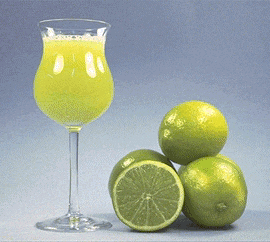


|
The × may
refer to a
single plant: Citrus
limon × Citrus
medica means that the fruit is a hybrid of
lemon and citron. An × may
also refer to a whole species: Citrus
× paradisi
is the Latin
name used of the grapefruit meaning that it is
a man-made hybrid (of pomelo and orange) and
cannot as
such be found in nature.
Photographs
All photographs
used
in the Citrus Pages are published with the permission of the person or
organisation
holding the copyright.
The right to copy or publish the photograph is
retained by the copyright owner, whose name is given under
each
picture.
More information on the sources of the photographs is
given on the Photos
&
links page.
Literature and
references
Much information
on citrus
fruits is available both in printed form as well as on the Internet.
I have made an effort to ensure that
the botanical information and classifications are as correct and
up-to-date as possible.
The botanical information used on Citrus Pages is based on the
following literature and it has been amended
and up-dated by the information from the recent scientific studies
listed at the bottom:
Editors: W. Reuther, H.J. Webber, L.D. Batchelor. University of
California Press © 1967
The magnum opus
of citrus
information unsurpassed in the wideness of its scope and the
thoroughness with which it handles its subject matter. Now available
also on the Internet.
Walter T.
Swingle and Philip C. Reece: The
Botany of Citrus and Its Wild Relatives. Chapter
3 of The
Citrus Industry Vol 1 pp 190 - 430. Originally published in 1943 this
is one of the best
known taxonomic descriptions of citrus fruit. Now also available in its
entirety on the Internet.
Robert
Willard Hodgson: Horticultural
Varieties of Citrus
Chapter 4 of The
Citrus Industry.
An extensive description of both common and rare cultivated varieties
of citrus.
Fresh Citrus Fruits. Edited by: W.F.Wardowski,
S. Nagy,
W.Grierson, Macmillan UK © 1986
Julia F.
Morton: Fruits
of Warm Climates,
Creative Resource Syst., Inc. Miami, FL. © 1987
A thorough
presentation of commercially important citrus types and their history,
cultivation and food uses. Available on the Internet.
R. Cottin:
Citrus
of the World,
A citrus directory, SRA - INRA - CIRAD © 2002 A
catalogue
of more than 5500 citrus names, classified by botanical, common and
cultivar names. Includes a useful comparison of Swingle and Tanaka
terminology listing equivalent names of both.
D.J. Mabberley:
The Plant-Book, Second edition, Oxford University Press © 1997
D.J. Mabberley:
The Plant-Book, Third edition, Cambridge University Press UK © 2008
James Saunt:
Citrus Varieties of the World,
Second edition, Sinclair UK © 2000, 160 pp.
University of California, Riverside Citrus
Variety Collection, Citrus
varieties
A presentation of the most important common varieties at the UCR
Experiment Station.
University of California, Riverside CCPP
Citrus Clonal Protection Program, Variety
data
A presentation of the holdings of the CCPP
citrus variety collection with the relevant data.
Répartition des variétés par espèces. Station de recherche agronomique
SRA-INRA Corse.
Détails des variétés par espèces. Station de recherche agronomique
SRA-INRA Corse.
These two large databases of the holdings of the Corsican citrus
station are, alas, no longer available on the Internet.
A
classification for
edible Citrus
D.J.
Mabberley, Rijksherbarium, University of Leiden, Netherlands
and
Royal BotanicGardens, Mrs Macquaries Road,
Sydney,
NSW 2000,
Australia (1997) Telopea 7(2): 167–172.
http://www.rbgsyd.nsw.gov.au/__data/assets/pdf_file/0019/73216/Tel7Mab167.pdf
RFLP analysis of the origin of Citrus bergamia, Citrus
jambhiri,
and Citrus
limonia
Federici, C.T., Roose, M.L. and Scora, R.W.
2000. Acta Hort. (ISHS) 535:55-64
http://www.actahort.org/books/535/535_6.htm
http://plantbiology.ucr.edu/faculty/roose.html#2
Citrus
phylogeny and genetic origin of important species as investigated by
molecular markers
E. Nicolosi, Z. N. Deng, A. Gentile, S. La Malfa,
G. Continella and E. Tribulato
Istituto di Coltivazioni arboree, University of
Catania, Italy. Theoretical and Applied Genetics 100(8): 1155-1166.
http://www.springerlink.com/content/tjggcl5wyyu6l69d/
Australian
Citreae with notes on other Aurantioideae (Rutaceae)
Mabberley, D.J. Rijksherbarium,
University of
Leiden, Netherlands and Royal Botanic Gardens,
Mrs Macquaries Road,
Sydney, NSW 2000, Australia (1998) Telopea 7(4):333–344.
http://www.rbgsyd.nsw.gov.au/__data/assets/pdf_file/0003/73236/Tel7Mab333.pdf
CITRUS
Linnaeus, Sp. Pl. 2: 782. 1753.
Zhang Dianxiang, David J. Mabberley, Fl. China 11:
90–96. 2008.
http://flora.huh.harvard.edu/china/PDF/PDF11/Citrus.pdf
CHEMICAL
CONSTITUENTS OF ESSENTIAL OILS FROM THE RUTACEAE FAMILY
M. A. Nor Azah, J. Abdul Majid, S. Abu Said , M. Z. Zaridah
& Z.
Mohd. Faridz
Forest Research Institute
Malaysia (FRIM)
http://info.frim.gov.my/cfdocs/infocenter/highlight/IRPA_2005/Pg%20152-155.pdf
Molecular
characterization and genetic diversity among
Japanese acid citrus based on RAPD markers
A.
Asadi Abkenar and S. Isshiki 2002. Laboratory of Biotechnology and
Plant
Breeding, Saga University, Japan.
Journal
of Horticultural Science & Biotechnology (2003)
78
(1)
108-112
http://www.citrusvariety.ucr.edu/citrus/documents/JapaneseAcidCitrus.pdf
Native
Australian Citrus – wild species, cultivars and hybrids
Primary Industries and Resources, Government of South
Australia (PIRSA)
FS No: 7/03
http://www.ausbushfoods.com/new/upload/factsheets/ancitrus.pdf
|
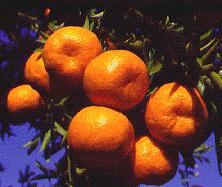




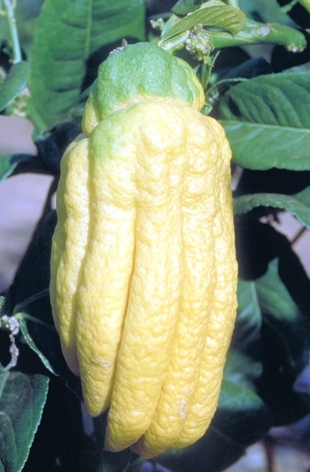


|
Web optimisation
Citrus Pages are optimised for 1280×1024 screen resolution on Windows
Internet Explorer 8 and Firefox.
The design and
compilation of Citrus Pages are mine.
Comments and suggestions are welcome.
Have fun!
Jorma Koskinen
e-mail
to Citrus
Pages
These
are my principles. If you don't like them, I have others. (Groucho
Marx)
|


































